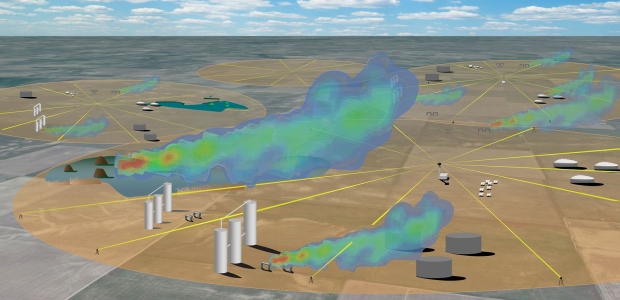
New Method Shown for Detecting Methane Leaks Inexpensively
As described in their paper, the researchers tested this method successfully on a Colorado well field containing placed methane leak sources.
Researchers at the National Institute of Standards and Technology, the University of Colorado Boulder, and the National Oceanic and Atmospheric Administration have successfully demonstrated a method for continuously and cost-effectively monitoring leaks of methane (CH4) and other trace gases with extreme precision over large areas, NIST reported on March 22, describing it as a "novel solution that features an innovative NIST adaptation of a Nobel Prize-winning technology."
The solution, described in a paper published in the journal Optica, is important because methane leaks are harmful to the environment and also because preventing them and capturing currently wasted methane for sale could raise more than $2 billion yearly, according to the agency.
Its news release cites EPA as the source for estimating the methane leaked or intentionally vented from human activities such as natural gas exploration, storage and pipelining; coal mining; chemical manufacturing and processing; waste management; and livestock farming accounts for about 10 percent of the warming potential of all greenhouse gas emissions in the United States.
Current methods rely heavily on inspectors using infrared cameras to look for gas plumes one by one across large sites, which is time-consuming and expensive. NIST and its partners developed a novel observing system that combines the world's first in-the-field dual-frequency comb laser spectrometer and an array of corner cube retroreflectors, it says. The spectrometer is based on the frequency comb technology for which NIST's John Hall shared the 2005 Nobel Physics Prize.
The new trace gas monitoring system uses a NIST-developed evolution of the frequency comb technology, a dual-comb laser spectrometer where a second comb is added. "When paired, the combs can act like hundreds of thousands of laser spectrometers working in unison and yield a device that is 10 to 100 times better than a traditional spectrometer and very sensitive to leaks, even at a great distance," said Ian Coddington, a NIST physicist and co-author of the paper. "It is comparable to standing at the Lincoln Memorial in Washington, D.C., and detecting one person exhaling among hundreds near the Washington Monument at the other end of the National Mall."
As described in their paper, the researchers tested this method successfully on a Colorado well field containing placed methane leak sources.